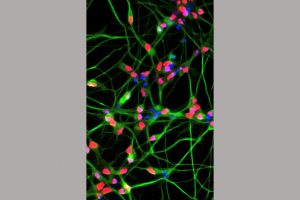
The following was originally published in Johns Hopkins Medicine’s Newsroom.
A new study using genetically engineered mice and human cell and tissue samples has added to evidence that higher levels of inflammatory chemicals involved in fat metabolism occur in people with amyotrophic lateral sclerosis (ALS), the neuromuscular disorder, also known as Lou Gehrig’s disease.
The study, which focused on genetic pathways involved in how spinal motor cells process fats, found that compared with people without ALS, those with the disorder have about 2.5-fold higher levels of arachidonic acid, a lipid commonly found in the fatty parts of meat and fish and that is known to spur on inflammatory processes needed to repair wounds or tissue damage.
Notably, by tampering with the arachidonic acid pathway in mice bred to develop the biological hallmarks of ALS, the researchers say they were able to reduce the condition’s muscle-weakening symptoms in the mice — which experienced a 20%–25% increase in grip strength — and extend their survival by two to three weeks.
A report on the work, led by Johns Hopkins Medicine researchers, appears in the Nov. 15 issue of Nature Neuroscience. The technology is available for licensing through Johns Hopkins Technology Ventures.
The scientists used caffeic acid, an anti-inflammatory compound found naturally in coffee, tea, tomatoes and wine, to tamp down the arachidonic acid pathway, but they caution that people with ALS should not rush to treat themselves with the substance, which is sold as an unregulated dietary supplement. More studies are needed to determine safe levels of a caffeic acid supplement — some reports have indicated potentially harmful side effects, including cancers and gut problems.
Also sold in alleged muscle enhancement powders, arachidonic acid in inappropriate and untested amounts can be toxic, triggering brain cells to die off, experts say.
Some 30,000 people in the U.S. have ALS, according to the researchers, and about 10% of cases can be attributed to heritable genetic alterations. The rest occur sporadically. There is no known curative treatment.
The new study built on the established observation that though patients with ALS lose most of their muscle control because of damaged spinal motor neurons, generally they can still control their eye movements, which are guided by ocular neurons, says Gabsang Lee, D.V.M., Ph.D., associate professor of neurology at the Johns Hopkins University School of Medicine and member of the Institute for Cell Engineering at Johns Hopkins Medicine.
To explore the potentially important genetic differences between disease-free ocular neurons and spinal motor neurons that bear the brunt of ALS, Lee’s team studied stem cell lines they cultivated from a person with ALS. Looking at the genetic pathways actively making proteins, the scientists found more activity in genes that control lipid metabolism — the process in which cells process fat.
Lee then sent to colleagues at the University of Southern California samples of ocular neurons and spinal motor neurons from 17 people with ALS who were treated at The Johns Hopkins Hospital, and six sample sets of people without the condition. The researchers confirmed that spinal motor neurons of the people with ALS contained completely different amounts and types of lipids than did ocular neurons, compared to people without the condition.
Further analysis to identify which lipid pathways were most altered between cells of people with ALS and cells of people without the disease showed that one pathway stood out — arachidonic acid.
An omega-6 fatty acid that controls the body’s inflammatory response, arachidonic acid has been linked to Alzheimer’s and Parkinson’s diseases and, two decades ago, researchers found higher than expected amounts of the enzyme in neuromuscular tissue of people with ALS.
Lee says lipid pathways have been highly studied because they are critical parts of the cell membrane, that enable the flow of molecules in and out of cells. Cell membranes often break when there is inflammation, and Lee says the body must tightly regulate arachidonic acid, or inflammation can run amok and send signals to the immune system to destroy neural tissue.
To further test the role of arachidonic acid, the investigators performed experiments to reverse its effects by feeding caffeic acid first to fruit flies genetically engineered to develop ALS-type symptoms. Flies fed caffeic acid were able to move around more, climb up the test tube more often and live longer than flies that did not receive the compound.
The scientists then conducted similar experiments with caffeic acid in mice bred to develop ALS, and those that received the compound lived two to three weeks longer than mice not fed the compound.
Although the new evidence may one day offer potential new strategies for therapy, Lee says that questions linger. “We don’t know yet why ocular and spinal neurons differ in lipid metabolism or what percentage of ALS patients have alterations in the arachidonic acid pathway,” he says.
Lee has filed provisional patents for technology related to the potential use of the arachidonic acid pathway to treat ALS.
Funding for the research was provided by the Robert Packard Center for ALS Research, the National Institutes of Health (R01NS093213), the National Research Foundation of Korea, the Donald E. and Delia V. Baxter Foundation, and the Department of Molecular Microbiology and Immunology at the University of Southern California.
In addition to Lee, scientists who conducted the research are Hojae Lee, Sandeep Kumar Dubey, Kai Ruan, Seong-Hyun Park, Shinwon Ha, Irina Kovlyagina, Seongjun Kim, Yohan Oh, Hyesoo Kim, Sung-Ung Kang, Thomas Lloyd and Nicholas Maragakis from Johns Hopkins; Jae Jin Lee and Hyungjin Eoh from the University of Southern California; Na Young Park and Young Bin Hong from Dong-A University in South Korea; Taeyong Kim from San Diego State University; Su Bin Lim from the Ajou University School of Medicine in South Korea, and Kyung-tai Kim and Mi-Ryoung Song from the Gwangju Institute of Science and Technology in South Korea.